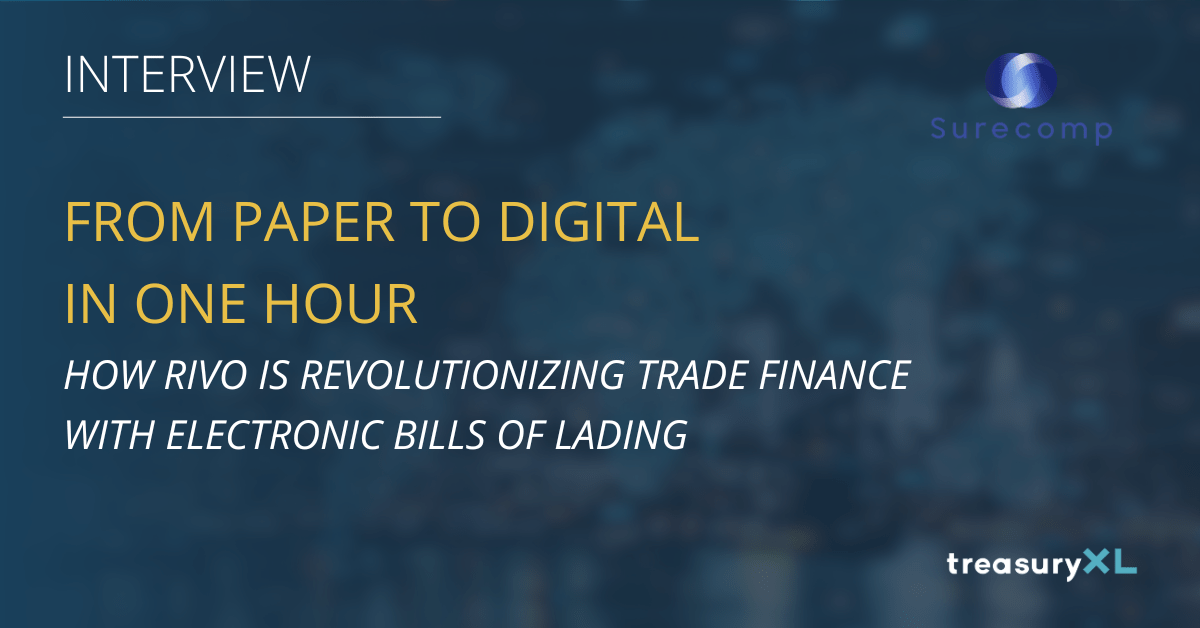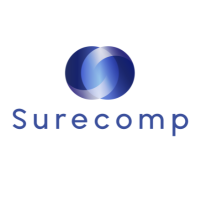From Paper to Digital in One Hour: How RIVO is Revolutionizing Trade Finance with Electronic Bills of Lading
By Surecomp
Surecomp recently issued a press release announcing the successful completion of electronic bills of lading (eBL) transactions using their collaborative trade finance platform RIVO. This development represents a significant step forward in the adoption of paperless maritime trade.
treasuryXL asked Surecomp several questions about these successful eBL transactions on RIVO to gain more insights into this innovative process and its implications for the future of trade finance.
Find the press release here

What is the significance of electronic Bills of Lading (eBL) in modern trade finance?
There are two documents that every single Letter of Credit (LC) requires in order to be processed – the Bill of Lading (BL) and the invoice. Though not a complete walk in the park, digitizing the invoice is easy compared with digitizing the more complex Bill of Lading.
Digitization of course is multi-purpose, adding huge value to both operational and cost efficiency, fraud risk mitigation, enhanced security, and supply chain resilience. Improving the service that banks can deliver to their corporate customers, improves the speed and quality with which corporates can manage the financial support with their trade counterparts.
Therefore, the electronic Bill of Lading (eBL) is pivotal when aiming to move to a fully digital process, which is a necessity when considering modern trade finance. From our customer research, we find that it takes parties several days on average to process documents from the presentation. The industry needs to move to eBLs to more efficiently process verified data and significantly accelerate the turnaround times.
How does RIVO™ make eBL transactions faster?
RIVO™ enables all trade finance parties (exporter, advising bank, issuing bank, importer) to manage any eBL from any issuing platform in one unified workflow. This significantly reduces the processing time and operational barriers for each team managing eBLs, such as the need for training on the individual workflow, user interface and peculiarities of each eBL platform.
By centralizing all eBLs in one digital hub irrespective of issuer, RIVO™ enables the trade finance experts to gain expertise and trust in handling digital BLs while reducing the time taken and operational risk across the entire process.
Read also: Top Trade Finance Trends to Watch in 2024
What key features does RIVO provide for effective eBL management?
RIVO™ enables centralized workflow management of the eBL under a Letter of Credit across the full lifecycle of both instruments, i.e. from presentation all the way to release of goods and termination of the LC. This includes initiating a change in ownership and forwarding or endorsing the ownership from the exporter all the way to the importer, be it through the banks or directly.
The key is that RIVO™ is orchestrating the ownership transfer on the eBL issuing platforms, so the ‘truth’ and transparency will always be on the respective eBL platforms, making it very straightforward for parties to collaborate.
How did the pilot transactions with MSC and WaveBL demonstrate RIVO’s impact on global trade efficiency?
Having representatives from each party participate in the pilot (from shipping carriers and eBL platforms to corporates and banks) truly demonstrated the power of the exercise. Each party could experience first-hand how original data from MSC as the carrier initiated the creation of an eBL on the WaveBL platform, which was then attached to an LC on the RIVO™ platform. This provided an immediate impact with an increased level of trust that parties could attribute to the transaction data.
Experiencing the seamless API-driven connection from the carrier through the eBL platform to the document presentation in RIVO™ without friction builds solid trust in the accuracy and immutability of the data. Furthermore, participants acknowledged that data was available much faster, enabling more advanced visibility of incoming shipments helping for example the importer’s team to more efficiently prepare to receive the goods.
How does Surecomp facilitate bank adoption of eBLs through the RIVO™ platform?
Using the RIVO™ platform enables banks to process any type of eBL. Once the exporter uploads an eBL and presents it to the bank, the downstream parties can see the document, similar to the paper process.
Today, some eBL platforms restrict read-only access rights to those parties that onboarded their platform, so management through RIVO™ can ease significant barriers to adoption by making it easier for the banks to include eBL document checking into their standard operational workflow.
What are the next steps for Surecomp in promoting eBL adoption and trade finance digitalization?
To talk about it, talk about it, talk about it…
We just hosted a regional Customer Summit in Germany where many of our corporate customers were sharing their digitization success stories and urging other corporates and banks to get started as soon as possible. We’re a trade finance technology vendor, providing an end-to-end solution from the bank’s back-office system all the way through to our collaborative RIVO™ platform.
The greater the adoption of these solutions, the greater the benefit for everyone in the ecosystem, so we aim to continue increasing awareness of how digitization enables global trade growth. We can now prove that there is an easy, seamless solution for processing eBLs and we can showcase that operations teams actually appreciate the benefits of it.
So the only thing the corporates and their banking partners need to do is – do it! Get started now.
Can’t get enough? Check out these latest items
 https://treasuryxl.com/wp-content/uploads/2024/10/Embat-BLOGS-featured-2.png
200
200
treasuryXL
https://treasuryxl.com/wp-content/uploads/2018/07/treasuryXL-logo-300x56.png
treasuryXL2026-01-12 07:00:432026-01-12 03:36:46Finance Automation Is Having Its Sourdough Starter Moment
https://treasuryxl.com/wp-content/uploads/2024/10/Embat-BLOGS-featured-2.png
200
200
treasuryXL
https://treasuryxl.com/wp-content/uploads/2018/07/treasuryXL-logo-300x56.png
treasuryXL2026-01-12 07:00:432026-01-12 03:36:46Finance Automation Is Having Its Sourdough Starter Moment https://treasuryxl.com/wp-content/uploads/2024/01/Template_VACANCY-featured.png
200
200
treasuryXL
https://treasuryxl.com/wp-content/uploads/2018/07/treasuryXL-logo-300x56.png
treasuryXL2026-01-09 07:00:142026-01-08 14:00:46Vacancy Business Treasurer – Tilburg Region
https://treasuryxl.com/wp-content/uploads/2024/01/Template_VACANCY-featured.png
200
200
treasuryXL
https://treasuryxl.com/wp-content/uploads/2018/07/treasuryXL-logo-300x56.png
treasuryXL2026-01-09 07:00:142026-01-08 14:00:46Vacancy Business Treasurer – Tilburg Region https://treasuryxl.com/wp-content/uploads/2024/10/Carlo-_BLOGS-Expert-featured-2.png
200
200
treasuryXL
https://treasuryxl.com/wp-content/uploads/2018/07/treasuryXL-logo-300x56.png
treasuryXL2026-01-08 08:57:102026-01-08 08:57:37SWIFT entering the blockchain world
https://treasuryxl.com/wp-content/uploads/2024/10/Carlo-_BLOGS-Expert-featured-2.png
200
200
treasuryXL
https://treasuryxl.com/wp-content/uploads/2018/07/treasuryXL-logo-300x56.png
treasuryXL2026-01-08 08:57:102026-01-08 08:57:37SWIFT entering the blockchain world https://treasuryxl.com/wp-content/uploads/2025/12/TreasurySpring-van-Template-4.png
200
200
treasuryXL
https://treasuryxl.com/wp-content/uploads/2018/07/treasuryXL-logo-300x56.png
treasuryXL2026-01-07 07:00:572026-01-06 15:20:332026 Macro outlook
https://treasuryxl.com/wp-content/uploads/2025/12/TreasurySpring-van-Template-4.png
200
200
treasuryXL
https://treasuryxl.com/wp-content/uploads/2018/07/treasuryXL-logo-300x56.png
treasuryXL2026-01-07 07:00:572026-01-06 15:20:332026 Macro outlook https://treasuryxl.com/wp-content/uploads/2023/03/Treasurer-Search-Logo.png
200
200
treasuryXL
https://treasuryxl.com/wp-content/uploads/2018/07/treasuryXL-logo-300x56.png
treasuryXL2026-01-06 11:24:052026-01-08 09:54:11Ambitious Treasury Analyst @Treasurer Search
https://treasuryxl.com/wp-content/uploads/2023/03/Treasurer-Search-Logo.png
200
200
treasuryXL
https://treasuryxl.com/wp-content/uploads/2018/07/treasuryXL-logo-300x56.png
treasuryXL2026-01-06 11:24:052026-01-08 09:54:11Ambitious Treasury Analyst @Treasurer Search https://treasuryxl.com/wp-content/uploads/2025/12/Carlo-_BLOGS-Expert-featured-1.png
200
200
treasuryXL
https://treasuryxl.com/wp-content/uploads/2018/07/treasuryXL-logo-300x56.png
treasuryXL2026-01-06 07:00:082026-01-05 15:33:25Beyond the Numbers: The Human Side of Treasury
https://treasuryxl.com/wp-content/uploads/2025/12/Carlo-_BLOGS-Expert-featured-1.png
200
200
treasuryXL
https://treasuryxl.com/wp-content/uploads/2018/07/treasuryXL-logo-300x56.png
treasuryXL2026-01-06 07:00:082026-01-05 15:33:25Beyond the Numbers: The Human Side of Treasury https://treasuryxl.com/wp-content/uploads/2026/01/event-200.png
200
200
treasuryXL
https://treasuryxl.com/wp-content/uploads/2018/07/treasuryXL-logo-300x56.png
treasuryXL2026-01-05 08:52:442026-01-05 08:54:5810th Edition Banking Book Risk Management conference
https://treasuryxl.com/wp-content/uploads/2026/01/event-200.png
200
200
treasuryXL
https://treasuryxl.com/wp-content/uploads/2018/07/treasuryXL-logo-300x56.png
treasuryXL2026-01-05 08:52:442026-01-05 08:54:5810th Edition Banking Book Risk Management conference https://treasuryxl.com/wp-content/uploads/2023/03/Treasurer-Search-Logo.png
200
200
treasuryXL
https://treasuryxl.com/wp-content/uploads/2018/07/treasuryXL-logo-300x56.png
treasuryXL2025-12-30 09:19:492025-12-30 09:19:49Business Treasurer @Treasurer Search
https://treasuryxl.com/wp-content/uploads/2023/03/Treasurer-Search-Logo.png
200
200
treasuryXL
https://treasuryxl.com/wp-content/uploads/2018/07/treasuryXL-logo-300x56.png
treasuryXL2025-12-30 09:19:492025-12-30 09:19:49Business Treasurer @Treasurer Search https://treasuryxl.com/wp-content/uploads/2025/12/Copy-of-Live-Session-Nomentia-1.png
200
200
treasuryXL
https://treasuryxl.com/wp-content/uploads/2018/07/treasuryXL-logo-300x56.png
treasuryXL2025-12-19 08:49:372025-12-19 09:41:43Recap & Recording: Corporate Treasury in 2026 and beyond
https://treasuryxl.com/wp-content/uploads/2025/12/Copy-of-Live-Session-Nomentia-1.png
200
200
treasuryXL
https://treasuryxl.com/wp-content/uploads/2018/07/treasuryXL-logo-300x56.png
treasuryXL2025-12-19 08:49:372025-12-19 09:41:43Recap & Recording: Corporate Treasury in 2026 and beyond


